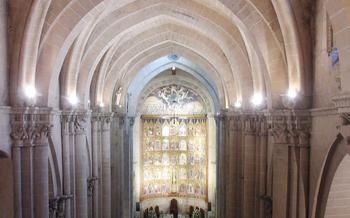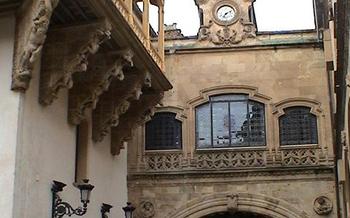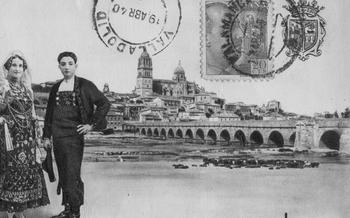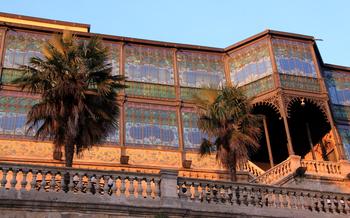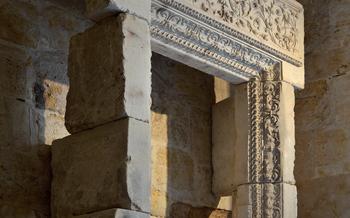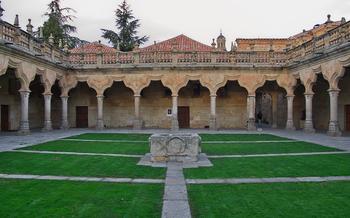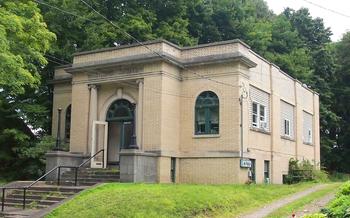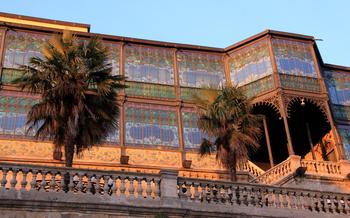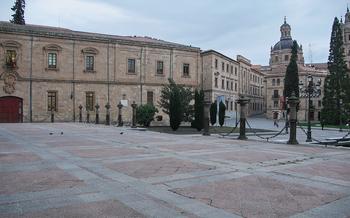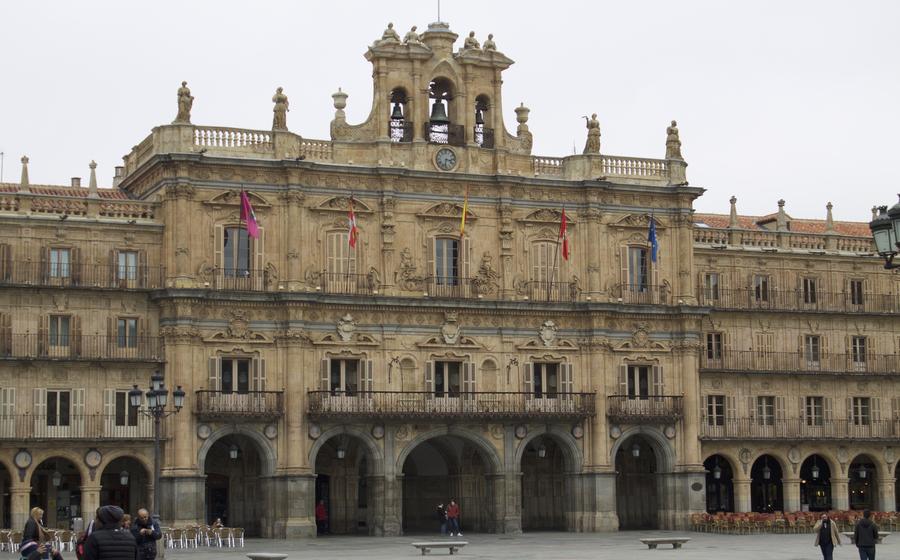
Salamanca City Hall
- Plaza Mayor: The Heart of Salamanca
- Salamanca City Hall
- Plaza del Corrillo: A Vibrant Hub of History and Entertainment
- Medieval Wall: A Journey Through History
- Casa de las Conchas
- Clerecía de Salamanca: A Baroque Masterpiece
- Convento de San Esteban
- Museo Taurino: A Journey into the World of Bullfighting
- Parque de la Alamedilla: A Haven of Tranquility
- Puente Romano: A Journey Through Time
- Museo Art Nouveau y Art Déco: A Journey Through Artistic Movements
- Insider Tip: Unveiling the Hidden Gem of Salamanca
Plaza Mayor: The Heart of Salamanca
In the heart of Salamanca's Old Town lies the Plaza Mayor, a captivating square that has stood as the city's centerpiece since the 18th century. This architectural masterpiece, a testament to the city's rich history, showcases Baroque-style grandeur with intricate carvings, graceful arches, and a harmonious symmetry that draws visitors from around the world.
Strolling through the Plaza Mayor is like stepping back in time, where the echoes of history intertwine with the vibrant energy of modern-day Salamanca. The square pulsates with life, hosting a myriad of events, from bustling markets to lively concerts and festivals. Take a seat at one of the many restaurants or cafes that line the plaza, savor a delicious meal, and immerse yourself in the infectious ambiance that envelops this iconic square.
Whether you're a history buff, an architecture enthusiast, or simply seeking a taste of Salamanca's vibrant spirit, the Plaza Mayor promises an unforgettable experience. Let the beauty of its surroundings captivate you, soak up the convivial atmosphere, and embrace the essence of this remarkable city that beats at the heart of the Plaza Mayor.
Salamanca City Hall
The Salamanca City Hall is an architectural masterpiece that stands as a testament to the city's rich history and heritage. Constructed between the 15th and 16th centuries, it seamlessly blends Gothic and Renaissance styles, showcasing intricate details that captivate the eye. The grand staircase, adorned with intricate carvings, leads visitors to the ornate chambers, where they can marvel at the building's preserved grandeur. Guided tours are available, offering insights into the history and significance of this iconic landmark. Visitors may also encounter temporary exhibitions or events hosted within the city hall, adding to its vibrant cultural atmosphere.
Plaza del Corrillo: A Vibrant Hub of History and Entertainment
Plaza del Corrillo, located in the heart of Salamanca's Old Town, holds a unique charm that blends historical significance with a lively ambiance. Once the site of the city's bullring, dating back to the 18th century, the plaza now serves as a focal point for entertainment and cultural events.
The plaza's architectural beauty is evident in its graceful archway, known as the Arco del Corrillo, which frames the entrance to the square. The archway is adorned with intricate carvings and mythological figures, reflecting the city's rich artistic heritage.
The Plaza del Corrillo comes alive in the evenings, when locals and tourists gather to enjoy outdoor events, concerts, and performances. The square's vibrant atmosphere is further enhanced by the surrounding restaurants, cafes, and bars, which offer a variety of culinary delights and refreshments.
For a truly immersive experience, visit the Plaza del Corrillo during the city's annual bullfighting festival, known as the Feria de Salamanca. The festival, held in September, transforms the square into a lively arena, where visitors can witness the traditional spectacle of bullfighting and celebrate the city's cultural heritage.
Medieval Wall: A Journey Through History
The Medieval Wall, a testament to Salamanca's rich past, stands as a symbol of the city's resilience and strength. Erected in the 12th century, these ancient fortifications once served as a protective barrier against invaders, safeguarding the city's inhabitants and their way of life. Today, the wall's remnants offer a captivating glimpse into Salamanca's storied history, inviting visitors to embark on a journey through time.
Strolling along the wall's path, one can't help but be awed by the sheer scale and grandeur of this architectural marvel. The sturdy stone walls, weathered by centuries of history, whisper tales of battles fought and triumphs celebrated. As you follow the wall's winding course, you'll discover hidden corners and charming viewpoints that reveal breathtaking panoramas of the city and its surroundings.
For a truly immersive experience, begin your walk from the Puerta de San Pablo gate, a majestic entrance that once served as the main gateway to the city. From here, you'll embark on a journey that takes you past imposing towers, defensive ramparts, and secret passageways, each with its own unique story to tell.
As you explore the Medieval Wall, let your imagination soar and picture the city as it once was, a bustling hub of commerce and culture, protected by these formidable walls. The wall's enduring presence serves as a reminder of Salamanca's enduring spirit, a city that has stood the test of time and emerged stronger with each passing century.
Practical Tip:
- To fully appreciate the grandeur of the Medieval Wall, plan your visit during the golden hour, when the setting sun casts a warm glow on the ancient stones, creating a magical atmosphere that transports you back in time.
Casa de las Conchas
A Unique Architectural Marvel
Amidst the architectural wonders of Salamanca, the Casa de las Conchas stands out with its unique façade adorned with over 300 seashells. This intriguing element, symbolizing pilgrimage routes, hints at the building's rich history and connection to the ancient tradition of the Camino de Santiago.
Originally constructed in the 15th century as a palace for a wealthy merchant, the Casa de las Conchas is a captivating example of Gothic-Isabelline architecture. Its stunning façade, featuring intricate carvings and the distinctive seashells, has become an iconic symbol of Salamanca.
Today, the Casa de las Conchas serves as a public library and a museum, showcasing a diverse collection of historical artifacts, manuscripts, and artworks. Visitors can explore the building's grand interior, admiring its Mudejar-style ceiling, ornate fireplaces, and a collection of seashells from around the world.
To delve deeper into the history and symbolism of the Casa de las Conchas, guided tours are available. These tours provide insights into the building's construction, its connection to the Camino de Santiago, and the significance of the seashells that adorn its façade.
Practical Tip:
Join a guided tour to unravel the fascinating stories behind the Casa de las Conchas and gain a deeper appreciation for its architectural and historical significance.
Clerecía de Salamanca: A Baroque Masterpiece
Clerecía de Salamanca stands as a testament to the grandeur of Baroque and Churrigueresque architecture. Founded in the 17th century, this former Jesuit college and church played a pivotal role in the city's educational landscape. Its impressive façade, adorned with intricate carvings and sculptures, hints at the treasures that lie within.
Step inside to explore the church, a masterpiece of Baroque exuberance. Marvel at the soaring vaults, intricate frescoes, and the magnificent altarpiece, a testament to the skill of Spanish artisans. The adjoining cloister offers a tranquil oasis, with graceful arches and a central fountain creating a serene atmosphere.
Don't miss the university museum housed within the Clerecía. Here, you'll find a fascinating collection of historical artifacts, art, and science exhibits, shedding light on the institution's rich past. Ascend to the rooftop terrace for a breathtaking panorama of Salamanca. Capture the city's essence as you gaze upon its historic spires, domes, and the rolling countryside beyond.
Whether you're a history buff, an architecture enthusiast, or simply seeking a spiritual sanctuary, the Clerecía de Salamanca promises an unforgettable experience. Immerse yourself in its grandeur and discover the essence of this architectural masterpiece.
Convento de San Esteban
Architectural Beauty and Historical Significance
The Convento de San Esteban is a stunning example of Gothic and Renaissance architecture, showcasing a harmonious blend of styles. Founded in the 13th century, it is one of the oldest monasteries in Spain, with a rich history deeply intertwined with the city of Salamanca. Its impressive façade, adorned with intricate carvings and sculptures, hints at the treasures within.
Museum and Stunning Cloister
The Convento de San Esteban houses a museum that unveils the monastery's past and the Dominican Order's influence in the region. Visitors can explore a collection of religious art, sculptures, historical documents, and artifacts that provide insight into the monastery's significance. Don't miss the awe-inspiring cloister, a masterpiece of Gothic architecture with intricate carvings and colorful tiles. Its serene atmosphere invites contemplation and provides a glimpse into the monks' daily lives.
Practical Tips
- Guided tours are available to delve deeper into the history and symbolism of the monastery.
- Plan enough time to explore the entire complex, including the church, cloister, and museum.
- The Convento de San Esteban is a popular tourist destination, so it's advisable to visit during off-peak hours to avoid crowds.
Museo Taurino: A Journey into the World of Bullfighting
Museo Taurino, located in the heart of Salamanca, offers a unique and immersive experience for visitors interested in the history and culture of bullfighting, an integral part of Spanish tradition. Through interactive exhibits, artifacts, and costumes, the museum takes you on a journey through the origins and evolution of this controversial yet captivating spectacle.
Learn about the techniques and strategies employed by matadors, the breeding and selection of fighting bulls, and the significance of bullfighting in Spanish society. Discover the intricate rules and rituals that govern the corrida, and gain insights into the emotions and controversies surrounding this polarizing practice.
The museum's collection includes an impressive array of bullfighting memorabilia, such as trajes de luces (the elaborate costumes worn by matadors), capotes (capes), banderillas (barbed sticks), and estoques (swords). These artifacts provide a tangible connection to the world of bullfighting and allow visitors to appreciate the craftsmanship and artistry involved in this unique tradition.
Parque de la Alamedilla: A Haven of Tranquility
Amidst the bustling streets of Salamanca, the Parque de la Alamedilla offers a tranquil oasis for locals and visitors alike. Established in the 19th century, it holds the distinction of being one of the first public parks in Spain. With its lush gardens, serene walkways, and a variety of family-friendly attractions, the park provides a welcome respite from the urban buzz.
Stroll along the tree-lined paths, admiring the vibrant blooms and the meticulously manicured lawns. Take a moment to relax by the tranquil pond, watching the ducks glide gracefully across the water. For a touch of nostalgia, hop on the vintage carousel, a delight for both children and adults.
Families with young ones will find plenty to keep them entertained. The park features several playgrounds, each offering a range of activities for kids of all ages. Let them swing, slide, and climb to their heart's content while you keep an eye on them from a nearby bench.
Pack a delicious picnic and enjoy a leisurely lunch surrounded by nature. Find a shady spot beneath a tree or spread out a blanket on the grass. As you savor your meal, listen to the cheerful chirping of birds and the gentle rustling of leaves in the breeze.
The Parque de la Alamedilla is a true gem in the heart of Salamanca, offering a serene escape from the hustle and bustle of city life. Whether you're seeking a place to relax, enjoy a family outing, or simply soak up the beauty of nature, this park is sure to enchant you with its charm and tranquility.
Puente Romano: A Journey Through Time
The Puente Romano, a testament to ancient engineering prowess, stands as a symbol of Salamanca's rich history. Built by the Romans in the 1st century AD, this magnificent bridge spans the Tormes River with its 26 arches, each a silent witness to the passage of time. Its enduring structure has withstood the test of centuries, carrying countless travelers, merchants, and pilgrims across its sturdy span.
As you stroll along the bridge, the mesmerizing views of the river and the city skyline will captivate your senses. The Tormes River, a ribbon of life, meanders gracefully beneath, reflecting the golden hues of the setting sun. The city, with its honey-colored buildings and stately spires, forms a picturesque backdrop, creating a scene that is both awe-inspiring and serene.
Locals and tourists alike flock to the Puente Romano, drawn to its timeless charm and historical significance. Whether you choose to simply soak in the ambiance or embark on a leisurely walk, the bridge offers a unique perspective of Salamanca's beauty. As you cross from one side to the other, imagine the countless footsteps that have preceded you, each leaving an imprint on the bridge's storied past.
In the evenings, the Puente Romano takes on a magical aura as the city lights twinkle in the distance. The bridge's warm glow illuminates the surrounding area, creating an enchanting atmosphere that is perfect for romantic strolls or quiet contemplation. Whether you're a history buff, an architecture enthusiast, or simply someone who appreciates the beauty of ancient landmarks, the Puente Romano is an unmissable destination in Salamanca.
Museo Art Nouveau y Art Déco: A Journey Through Artistic Movements
The Museo Art Nouveau y Art Déco is a captivating showcase of artistic creations from the late 19th and early 20th centuries. Immerse yourself in the world of Art Nouveau and Art Déco, characterized by their distinct styles, intricate details, and vibrant colors. Explore a diverse collection of furniture, paintings, and sculptures, each piece a testament to the artistic genius of this era.
The museum's collection includes works by renowned Spanish artists, as well as international masters. Admire the sinuous lines and organic forms of Art Nouveau, represented by pieces like the elegant furniture of Antoni Gaudí. Marvel at the geometric shapes and bold colors of Art Déco, showcased in paintings by Tamara de Lempicka and sculptures by Josep Clarà.
Take advantage of the guided tours offered by the museum to gain insights into the history and significance of the exhibited works. Learn about the techniques and inspirations of the artists, and the social and cultural context that shaped these artistic movements.
After exploring the museum, take a stroll through the nearby streets to admire the city's Art Nouveau architecture. Salamanca boasts several stunning examples of this style, including the Casa Lis, a magnificent palace known for its intricate wrought-iron balconies and stained-glass windows. Combine your visit to the museum with a walk through these architectural wonders to fully immerse yourself in the artistic heritage of Salamanca.
Insider Tip: Unveiling the Hidden Gem of Salamanca
Beyond the iconic landmarks, Salamanca holds a secret treasure—the Patio Chico, a hidden gem nestled behind the bustling Plaza Mayor. This charming square exudes a unique ambiance, inviting you to delve into the city's cultural heart. Immerse yourself in the flavors of traditional Spanish cuisine at one of the many tapas bars or restaurants lining the square. As night falls, the Patio Chico transforms into a vibrant hub of activity, where locals and university students gather to enjoy the lively atmosphere. Discover the hidden corners of this enchanting square and let the city's vibrant spirit captivate you.
